FIFA World Cup
Qatar 2022
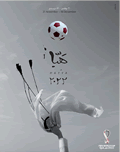 The selection of Qatar as hosts for the 2022 World Cup finals generated considerable criticism and allegations of corruption in the media not least because two members of FIFA's Executive Committee were suspended before the vote because of corruption. Subsequent investigations into widespread corruption among senior FIFA officials in May 2011 raised serious questions about how the Qatari delegation had influenced the vote and although an internal report found there had been no wrong doing the chief investigator, Michael J Garcia, criticised the report on his own enquiry as containing "numerous materially incomplete and erroneous representations." In May 2015 Swiss prosecuters opened an investigation into corruption and money laundering and in 2018 disgraced former FIFA president, Sepp Blatter, claimed that Qatar had used "black ops" to secure the hosting rights.
The selection of Qatar as hosts for the 2022 World Cup finals generated considerable criticism and allegations of corruption in the media not least because two members of FIFA's Executive Committee were suspended before the vote because of corruption. Subsequent investigations into widespread corruption among senior FIFA officials in May 2011 raised serious questions about how the Qatari delegation had influenced the vote and although an internal report found there had been no wrong doing the chief investigator, Michael J Garcia, criticised the report on his own enquiry as containing "numerous materially incomplete and erroneous representations." In May 2015 Swiss prosecuters opened an investigation into corruption and money laundering and in 2018 disgraced former FIFA president, Sepp Blatter, claimed that Qatar had used "black ops" to secure the hosting rights.
Due to Qatar's extreme summer heat the tournament was moved to November/December.
In the run up to the finals the poor treatment of foreign construction workers, recruited mainly from the Indian sub-continent, was constantly in the news. Housed in squalid barracks, most if not all had been forced to pay illegal fees to agents in their own countries to secure a job and basic pay was so low that many workers reached the end of their contracts in debt. Under the kafala system, workers were unable to change jobs and as contractors held their passports, returning home was not an option. Although the organising committee and Qatari government promised reforms to improve working conditions, a report by the Guardian in September 2022 found little had changed. Furthermore, due to the intense heat and lax safety regulations, it is believed that many workers have died during construction, perhaps numbering in the thousands
Some advocacy groups advised members of the LGBTQ+ communities not to travel to Qatar because of concerns that the authorities would not protect them from hostile locals (homosexuality is illegal in Qatar).
Notable absentees were the European Champions, Italy, who failed to negotiate the play-offs, and Russia who were suspended following the invasion of Ukraine.
Group A | Group B | Group C | Group D | Group E | Group F | Group G | Group H | Knock Out Stages
2018 Tournament | World Cup Index
Group A
 Qatar
Qatar
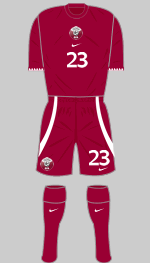
First
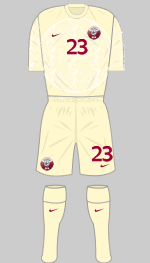
Second
Designer: Nike
The hosts are appearing in the World Cup finals for the first time. Their first choice kit is, as usual, maroon with a white graphic at the sleeve cuffs that mirrors the national flag. The change strip is pale beige with a circular graphic on the front that is supposed to evoke the pearls that are harvested from Qatar's coastal waters and/or swirling sandstorms. Take your pick.
The Qatari national side relies heavily on players recruited from across Africa to the "Aspire Football Dreams" academy,
the best of whom are offered Qatari citizenship. Of the 26 players in the World Cup squad, ten were born outside Qatar.

 Ecuador
Ecuador
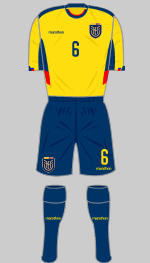
First

Second
Designer: Marathon
Ecuador's participation in the finals was in the balance because of a long-running controversy concerning Byron Castillo who, it was alleged was born in Colombia and entered Ecuador illegally. He was eventually cleared in 2021 but in September of this year the Daily Mail published details of an interview between the player and officials of the Ecuador FA in which he admits that the allegations were true. This was kept quiet by the FEF but FIFA reopened the investigation following a fresh complaint by the Chilean Football Federation. In September FIFA dismissed the complaint and confirmed Ecuador's place in the finals.



 Senegal
Senegal
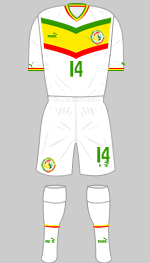
First
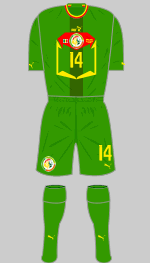
Second
Designer: Puma
The Lions of Teranga won the Africa Cup of Nations last year for the first time in their history and are appearing in the World Cup finals for the third time. In common with all of Puma's change shirts produced this year, the squad number is placed inside an individually designed frame that has the crest of the Senegal Football Federation, nickname and national flag emblazoned on it. The first choice kit is a stunner.



 Netherlands
Netherlands
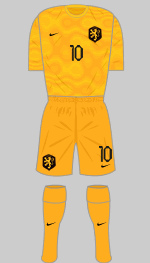
First
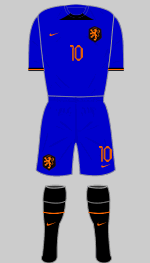
Second
Designer: Nike
The Dutch first kit is a rather more pale shade of orange than usual and has a subtle pattern printed into the shirt that is supposed to evoke the mane of the Dutch lion and represent "the fluidity of the Total Football tactical system" while the black detailing "represents the fighting spirit with which the team....will come forward during matches." The change shirt "is inspired by Dutch culture and the country's influential clothing brands that have left an important mark on soccer, streetwear and culture." It's hard to believe that Nike pays someone to write this piffle.







Group B
 England
England
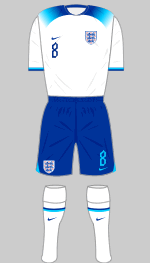
First
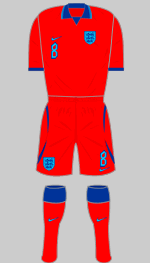
Second
Designer: Nike
Nike have added a bright shade of light blue as an accent colour to both kits, a shade that evokes some of the strips worn in the 90s. Red is reintroduced for the alternative with a shirt inspired by Italia 90 but the light blue accents clash unpleasantly with the base colour.






 Iran
Iran
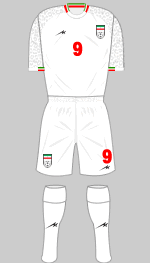
First
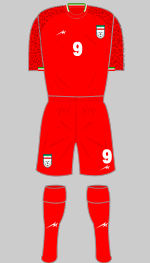
Second
Designer: Majid
Iran were the top ranked team in the Asian Football Confederation when qualifying began and they finished top of their groups in both the second and third qualifying rounds. Their kit is provided by Majid Inc (formerly Merooj Inc), a company founded and owned by Dr Majid Saedifar who was previously a physical therapist to the Iranian national team. Despite new kits being introduced in January, just days before the start of the World Cup the Iranian Football Federation announced a new set to be worn in the competition. These featured leopard spots sublimated into the sleeves


 United States
United States
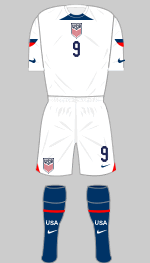
First
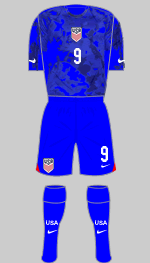
Second
Designer: Nike
The USMNT (United States Men's National Team, to distinguish them from their more illustrious sisters the USWNT) made hard work of qualifying, losing three of their 14 matches including defeat against Costa Rica in their last match. Superior goal difference allowed them to qualify while Costa Rica had to contest an inter-confederation play-off. Their kits are provided by Nike, the quintessentially American sportswear company and just in case we miss the point an outsize Nike swoosh appears on each sleeve. The new crest and white strip are a throwback to the first World Cup in 1930. The blue alternative looks like an accident with an ink bottle.




 Wales
Wales
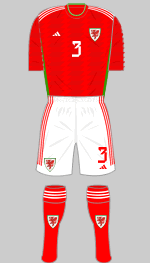
First
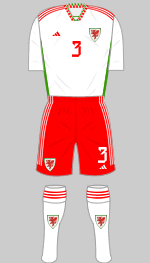
Second
Designer: Adidas
After distinguishing themselves at the last two Euros, Wales are now appearing in the World Cup finals for the first time in 64 years with a team that is being compared favourably to the 1958 side. They earned their place by beating Ukraine 1-0 in the play-off final on an emotional and bittersweet night in Cardiff. Their brand new strips are essentially simple but with complicated detailing. The red shirt has a tonal zig-zag pattern woven into the fabric while the detailing at the collar of the white shirt is repeated on the back at the armpit seam. Shorts and socks are interchangeable so the team can wear all-red or all-white if required.





Group C
 Argentina
Argentina
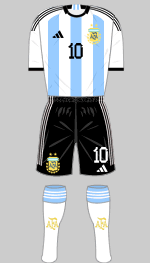
First
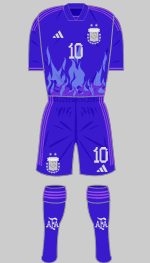
Second
Designer: Adidas
The Copa América champions are appearing in their 18th World Cup and are currently ranked third by FIFA. Their first choice kit is a straight forward but elegant interpretation on their traditional colours but with a twist on the reverse. The central blue stripe is split in two and the Sol de Mayo, the national emblem, is attached below the collar. The pale gold accents in the crest and on the socks give the outfit a distinguished look. The change strip is a bit sudden.
All of the kits provided by Adidas feature the company's new logo.




 Saudi Arabia
Saudi Arabia
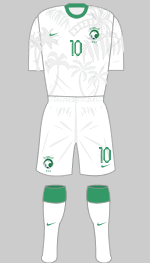
First
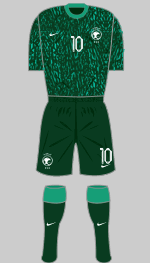
Second
Designer: Nike
In 2017 Saudi Arabia led a coalition of Arab states in severing diplomatic relations with Qatar and blocking air, sea and land access and trade. The dispute was at its heart over Qatar's friendly relations with Iran. The conflict rumbled on for almost four years until the sides were reconciled in January 2021. Had this not occurred it is doubtful that the Saudi team would be present for the World Cup finals.
There are no surprises with their kits: white trimmed with green is first choice (now with added palm-tree graphics) and we have another Nike word salad describing the green alternative. This "uses an all-over-print interpretation that builds on concepts from the 2018 and 2020 away kits to evoke a sense of speed and boldness."



 Mexico
Mexico
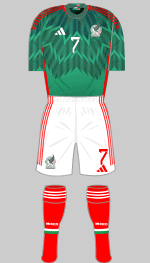
First
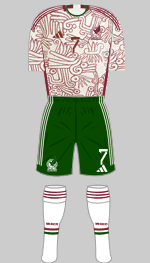
Second
Designer: Adidas
Mexico may not have a strong record in the World Cup finals but their kits rarely disappoint. As usual the first choice is in the traditional colours of the Mexican flag but Adidas have added a graphic inspired by Quetzalcoatal, the Aztec god of life and creator of the world. The name translates as "feathered serpent" and the graphic represents a cloak of feathers. The alternative also looks to the deep past with an Aztec inspired graphic on the shirt.




 Poland
Poland
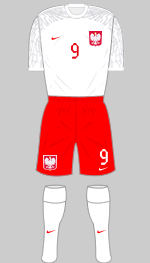
First
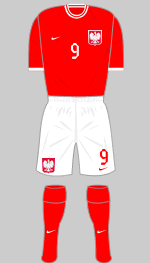
Second
Designer: Nike
Poland were scheduled to meet Russia in the qualifying play-offs but after the Russian team was indefinately suspended by FIFA Poland advanced straight to the final where they defeated Sweden. Wisely, Nike have appoached the Poles' new kits with respect for tradition and the minimum of gimmicks. The graphic across the shoulders and sleeves of the white shirt represents the eagles and nest of the white eagle, Poland's national symbol, while the change kit's only concession to novelty is a neat crew neck with white rings.




Group D
 France
France
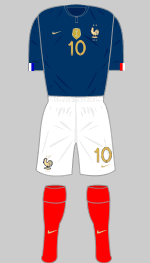
First
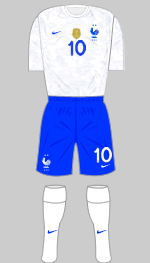
Second
Designer: Nike
The world champions are taking the field in an elegantly simple first choice kit in the colours of the French flag. (Emmanuel Macron changed the blue to a much darker shade in 2020 but no-one noticed.) The pale metallic gold applications set everything off beautifully. C'est chic n'est ce pas? The alternative is in white and "Game Royal" with a graphic sublimated into the shirt that is inspired by Toile de Jouy fabric. This contains iconic French symbols such the Arc de Triomphe, the Cockerel and, I have no doubt, the Eiffel Tower. Très jolie.



 Australia
Australia
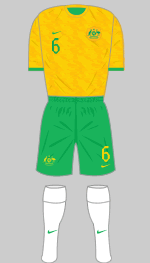
First
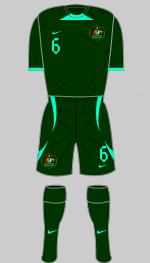
Second
Designer: Nike
Australia qualified by beating the United Arab Emirates in a play-off to decide the fifth and final place reserved for the Asian Football Confederation. As always they play in green and gold, this time matched with white socks. Let's leave it to Nike to tell us about the change strip.
"The bold obsidian away kit draws inspiration from the vivid sea colour with splashes of green glow to help Aussies show their pride on and off the pitch." Wait, there's more. "It is representative of the creatures, plants and reeds found in the water signaling the deep connection between Australians and coastal life."
Strewth mate!




 Denmark
Denmark
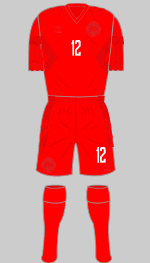
First
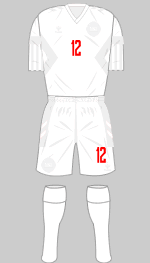
Second
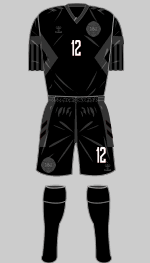
Third
Designer: Hummel
Overtly political gestures are banned from FIFA competitions but nevertheless the Danish Football Federation and Hummel are making a statement about Qatar's human rights record with their "toned down" strips. Hummel have stated that it "does not wish to be visible" in a tournament that "has cost thousands of lives." The third kit, which is unlikely to be needed, is black, the colour of mourning.




 Tunisia
Tunisia

First
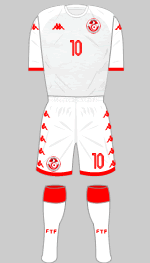
Second
Designer: Kappa
Afer a preliminary round, the African nations were divided into ten groups of four with the group winners going forward to the third round where they were drawn into five pairings to play-off. Tunisia beat Mali 1-0 over two legs to qualify. This is their fourth World Cup but they have yet to progress beyond the group stage. As usual their first choice kit is red and the alternative is white. The graphic on the front of the shirt represents a cuirass found in Tunisia in 1909 which is known as "The Armour of Hannibal."



Group E
 Spain
Spain
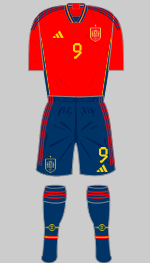
First
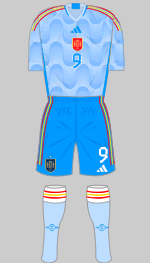
Second
Designer: Adidas
The glory days of Tiki-Taka that deiivered a World Cup and two Euros between 2008 and 2012 are a distant memory now but Spain are still a decent team. There's not much changed with their first choice strip from the previous version: navy and red trim replaces the gold but that colour is still used for the applications. The Spanish like to rock something a bit more flamboyant when they have to change and the new alternative strip does not disappoint.
Shortly before the competition begain it was announced that Spain would play in all-red. This was apparently at the behest of their Head Coach, Luis Enrique, who pointed out that the team is known as "La Roja" - The Reds.





 Costa Rica
Costa Rica
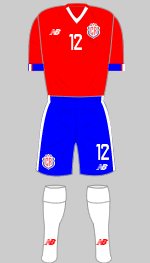
First
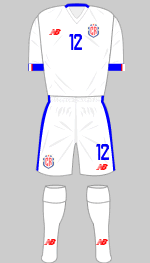
Second
Designer: New Balance
Costa Rica reached the finals by defeating New Zealand in an inter-confederation play-off and are appearing for the third consecutive time. Their playing kits match the colours of the Costa Rican flag and on this occasion they are refreshingly simple with no gimmicks. Having interchangeable elements allows the central American side to stay on the right side of the FIFA kit police without the need to bring extra luggage.




 Germany
Germany
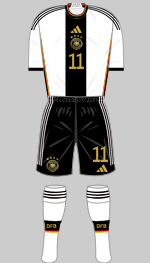
First
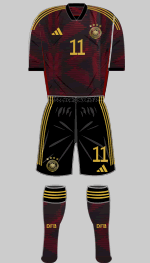
Second
Designer: Adidas
The addition of a broad black vertical stripe to Germany's white shirts might seem incongruous but it reflects the tops worn in Germany's first ever international match in 1908. The national colours are present in the subtle detailing while applications are rendered in metallic gold. The alternative features a complex abstract graphic in dark red on the shirt and is matched with black shorts and socks. We can assume that white shorts will be available.
Curiously
the DFB has opted to retain the old font for squad numbers and player names rather than the new version designed by Adidas for this competition and worn by all their other clients.





 Japan
Japan
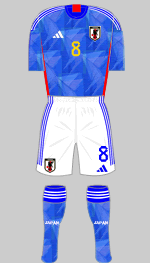
First
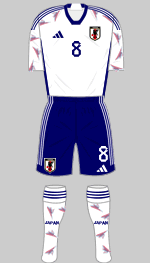
Second
Designer: Adidas
The Japan Football Association likes to commission kits with strong references to Japanese cultural icons. On this occasion this takes the form of a stylised origami cranes in flight.
The Blue Samurai have competed in every World Cup finals competition since 1998.



Group F
 Belgium
Belgium
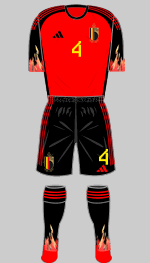
First
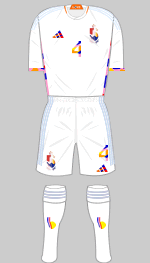
Second
Designer: Adidas
Belgium's recent record is impressive. Third place in the 2018 World Cup and quarter-finalists in Euro 2020. Their new first choice strip features flame graphics on the sleeves and socks, a reference to their nickname, The Red Devils. The change strip features unusual multicoloured trim and applications which refer to the Belgian Tomorrowland music festival. Perhaps we should expect Nike to produce a Glastonbury themed strip for England next year.




 Canada
Canada
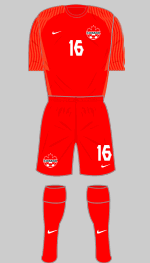
First
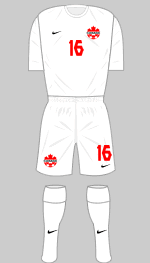
Second
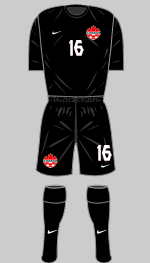
Third
Designer: Nike
Canada are the only team participating in the World Cup finals who are not getting new kit. According to Nike, "Canada Soccer is on a different kit development cycle." It is thought that it takes around 18 months for Nike to design and deliver a new bespoke strip which means the process would have had to begin in March 2021, three months before the current strips were launched. At the time it was far from certain that Canada would qualify so no effort was made to begin the design process.
This is the second time that Canada have appeared
in the finals. They made their debut in 1986.



 Morocco
Morocco
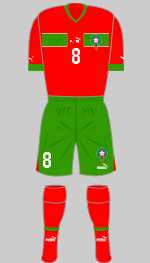
First
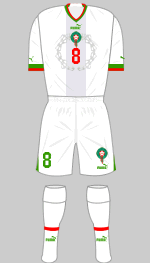
Second
Designer: Puma
The red and green first choice strip is modelled on the outfit worn in the 1998 World Cup finals (but with the colours reversed) while the alternative features Puma's frame device. This has attracted some criticism which I don't think is justified. The frames are all of different designs so to accuse Puma of imposing their own corporate image is unjustified.



 Croatia
Croatia
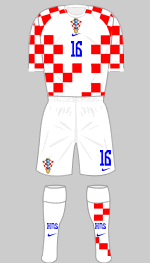
First
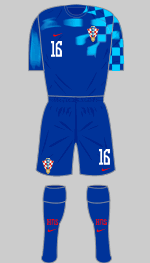
Second
Designer: Nike
Runners-up in 2018, Croatia are currently 12th in the FIFA rankings. Their unique checkered shirts present quite a challenge to designers who usually focus on varying the size of the checks but this time round they have opted to leave some of them out altogether. The alternative in two shades of blue has a different gimmick with checks on the left of the shirt bleeding gradually into the base colour.
In the past Croatia have played in their change strip more often than in their unique checkered shirts because these clash with team who play in red or in white. The latest version, however, is mainly white and may be considered to offer sufficient contrast against their group opponents.



Group G
 Brazil
Brazil
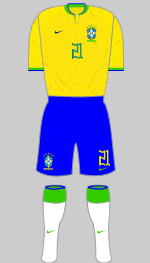
First
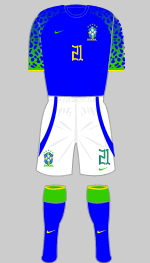
Second
Designer: Nike
The Canarinho have won the World Cup a record five times and are currently number one in the FIFA world rankings. They finished top of the CONMEBOL qualification group.
Their strips are in
the traditional bright colours and feature a jaguar print sublimated into the shirt fabric.





 Serbia
Serbia
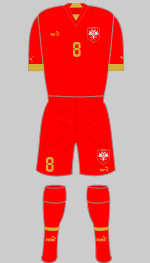
First
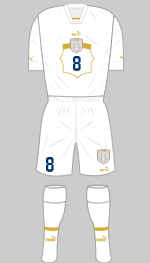
Second
Designer: Puma
The old badge of the Serbian Football Association, modelled on the Serbian coat of arms, has been replaced by a white double-headed eagle, a national symbol that matches the team's nickname.
Following the secession of Montenegro in 2006 the Serbian national team played in the red, blue and white colours of their national flag but since 2016 all-red has been preferred.



 Switzerland
Switzerland
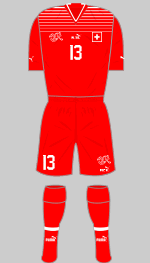
First
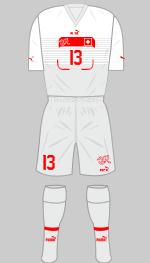
Second
Designer: Puma
Switzerland's record in the World Cup is modest but they have qualified for the finals of every tournament since 2006 and cannot be underestimated. In these days of monochromatic strips, the Swiss favour all-red with a white alternative that grades into pale grey.




 Cameroon
Cameroon
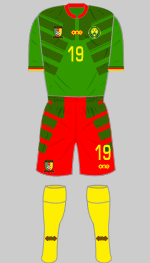
First
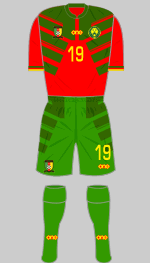
Second
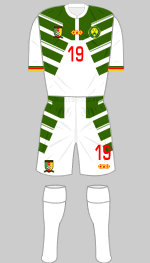
Third
Designer: One All Sports
In July the Cameroon football federation (Fecafoot) unilaterally tore up their contract with Le Coq Sportif and signed up with One All Sports, an American company more associated with motor sport than football. The new kits were finally launched less than three weeks before the start of the tournament and have attracted criticism for the poor quality of the finishing. Meanwhile a court found in favour of Le Coq Sportif stating that their contract with Fecafoot remains valid. Fecafoot have appealed but the case will not be pursued until after the World Cup ends. Many Cameroonian traders have been left with
hundreds of pre-ordered Le Coq Sportif which they now cannot sell.




Group H
 Portugal
Portugal
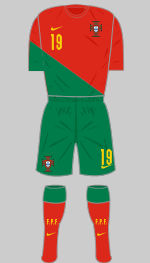
First
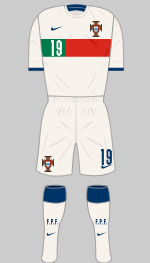
Second
Designer: Nike
After finishing second in their qualifying group Portugal beat Turkey and North Macedonia in home games in the Second Round. This is the 25th year that Nike have provided their kit which is officially in "Pepper Red" and green. The change strip is off-white with navy trim.




 Ghana
Ghana
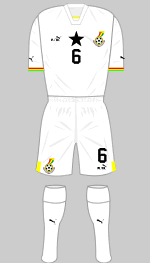
First
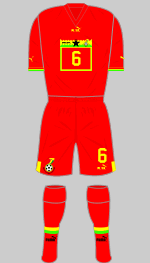
Second
Designer: Puma
The Black Stars are appearing in their fourth World Cup finals and will be hoping to improve on their 2010 performance when they reached the quarter-finals in South Africa. Their first choice kit is always white with the star from the national flag prominent. The alternative is red with trimmings in the national colours.





 Uruguay
Uruguay
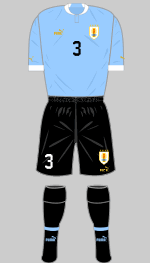
First
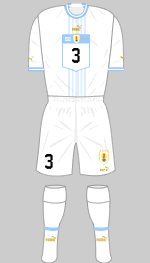
Second
Designer: Puma
There are no surprises with Uruguay's World Cup kits. The traditional light blue and black strip is set off with metallic gold applications while the white change strip has pale blue vertical stripes on the shirt as well as their own version of Puma's latest chest panel.



 South Korea
South Korea
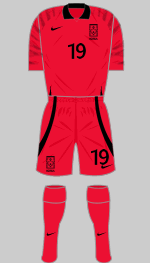
First
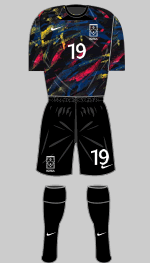
Second
Designer: Nike
South Korea have qualified for the World Cup finals in every tournament since 1986. As usual the main colour for their first choice strip is pinkish red ("Global Red"), with black trimmings. The change strip is black with abstract splashes of colour.



 The selection of Qatar as hosts for the 2022 World Cup finals generated considerable criticism and allegations of corruption in the media not least because two members of FIFA's Executive Committee were suspended before the vote because of corruption. Subsequent investigations into widespread corruption among senior FIFA officials in May 2011 raised serious questions about how the Qatari delegation had influenced the vote and although an internal report found there had been no wrong doing the chief investigator, Michael J Garcia, criticised the report on his own enquiry as containing "numerous materially incomplete and erroneous representations." In May 2015 Swiss prosecuters opened an investigation into corruption and money laundering and in 2018 disgraced former FIFA president, Sepp Blatter, claimed that Qatar had used "black ops" to secure the hosting rights.
The selection of Qatar as hosts for the 2022 World Cup finals generated considerable criticism and allegations of corruption in the media not least because two members of FIFA's Executive Committee were suspended before the vote because of corruption. Subsequent investigations into widespread corruption among senior FIFA officials in May 2011 raised serious questions about how the Qatari delegation had influenced the vote and although an internal report found there had been no wrong doing the chief investigator, Michael J Garcia, criticised the report on his own enquiry as containing "numerous materially incomplete and erroneous representations." In May 2015 Swiss prosecuters opened an investigation into corruption and money laundering and in 2018 disgraced former FIFA president, Sepp Blatter, claimed that Qatar had used "black ops" to secure the hosting rights. Qatar
Qatar

 Ecuador
Ecuador

 Senegal
Senegal

 Netherlands
Netherlands

 England
England

 Iran
Iran

 United States
United States

 Wales
Wales

 Argentina
Argentina

 Saudi Arabia
Saudi Arabia

 Mexico
Mexico

 Poland
Poland

 France
France

 Australia
Australia

 Denmark
Denmark


 Tunisia
Tunisia

 Spain
Spain

 Costa Rica
Costa Rica

 Germany
Germany

 Japan
Japan

 Belgium
Belgium

 Canada
Canada


 Morocco
Morocco

 Croatia
Croatia

 Brazil
Brazil

 Serbia
Serbia

 Switzerland
Switzerland

 Cameroon
Cameroon


 Portugal
Portugal

 Ghana
Ghana

 Uruguay
Uruguay

 South Korea
South Korea
